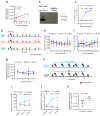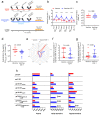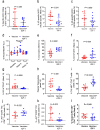In Vivo Treatment with Insulin-like Growth Factor 1 Reduces CCR5 Expression on Vaccine-Induced Activated CD4+ T-Cells
- PMID: 38005994
- PMCID: PMC10675829
- DOI: 10.3390/vaccines11111662
In Vivo Treatment with Insulin-like Growth Factor 1 Reduces CCR5 Expression on Vaccine-Induced Activated CD4+ T-Cells
Abstract
At the heart of the DNA/ALVAC/gp120/alum vaccine's efficacy in the absence of neutralizing antibodies is a delicate balance of pro- and anti-inflammatory immune responses that effectively decreases the risk of SIVmac251 acquisition in macaques. Vaccine efficacy is linked to antibodies recognizing the V2 helical conformation, DC-10 tolerogenic dendritic cells eliciting the clearance of apoptotic cells via efferocytosis, and CCR5 downregulation on vaccine-induced gut homing CD4+ cells. RAS activation is also linked to vaccine efficacy, which prompted the testing of IGF-1, a potent inducer of RAS activation with vaccination. We found that IGF-1 changed the hierarchy of V1/V2 epitope recognition and decreased both ADCC specific for helical V2 and efferocytosis. Remarkably, IGF-1 also reduced the expression of CCR5 on vaccine-induced CD4+ gut-homing T-cells, compensating for its negative effect on ADCC and efferocytosis and resulting in equivalent vaccine efficacy (71% with IGF-1 and 69% without).
Keywords: CCR5; CD4; HIV; IGF-1; SIV; T-cells; insulin-like growth factor.
Conflict of interest statement
The authors declare no conflict of interest.
Figures






Similar articles
-
Cholera toxin B scaffolded, focused SIV V2 epitope elicits antibodies that influence the risk of SIVmac251 acquisition in macaques.Front Immunol. 2023 Apr 21;14:1139402. doi: 10.3389/fimmu.2023.1139402. eCollection 2023. Front Immunol. 2023. PMID: 37153584 Free PMC article.
-
HIV vaccine candidate efficacy in female macaques mediated by cAMP-dependent efferocytosis and V2-specific ADCC.Nat Commun. 2023 Feb 2;14(1):575. doi: 10.1038/s41467-023-36109-8. Nat Commun. 2023. PMID: 36732510 Free PMC article.
-
Control of Heterologous Simian Immunodeficiency Virus SIVsmE660 Infection by DNA and Protein Coimmunization Regimens Combined with Different Toll-Like-Receptor-4-Based Adjuvants in Macaques.J Virol. 2018 Jul 17;92(15):e00281-18. doi: 10.1128/JVI.00281-18. Print 2018 Aug 1. J Virol. 2018. PMID: 29793957 Free PMC article.
-
Anti-V2 antibodies virus vulnerability revealed by envelope V1 deletion in HIV vaccine candidates.iScience. 2021 Jan 9;24(2):102047. doi: 10.1016/j.isci.2021.102047. eCollection 2021 Feb 19. iScience. 2021. PMID: 33554060 Free PMC article.
-
HIV-1 envelope, integrins and co-receptor use in mucosal transmission of HIV.J Transl Med. 2011 Jan 27;9 Suppl 1(Suppl 1):S2. doi: 10.1186/1479-5876-9-S1-S2. J Transl Med. 2011. PMID: 21284901 Free PMC article. Review.
Cited by
-
Vaccine induced mucosal and systemic memory NK/ILCs elicit decreased risk of SIV/SHIV acquisition.Front Immunol. 2024 Sep 5;15:1441793. doi: 10.3389/fimmu.2024.1441793. eCollection 2024. Front Immunol. 2024. PMID: 39301032 Free PMC article.
References
-
- UNAIDS . In Danger: UNAIDS Global AIDS Update 2022. Joint United Nations Programme on HIV/AIDS (UNAIDS); Geneva, Switzerland: 2022. p. 373.
-
- Johnson & Johnson Johnson & Johnson and Global Partners Announce Results from Phase 2b Imbokodo HIV Vaccine Clinical Trial in Young Women in Sub-Saharan Africa. PR Newswire. Aug 31, 2021.
Grants and funding
LinkOut - more resources
Full Text Sources
Research Materials
Miscellaneous

